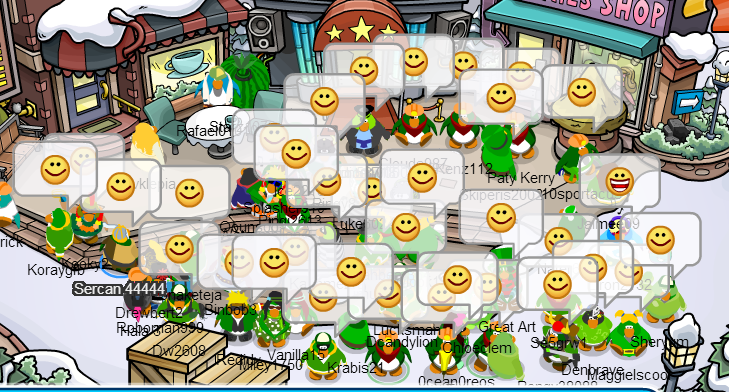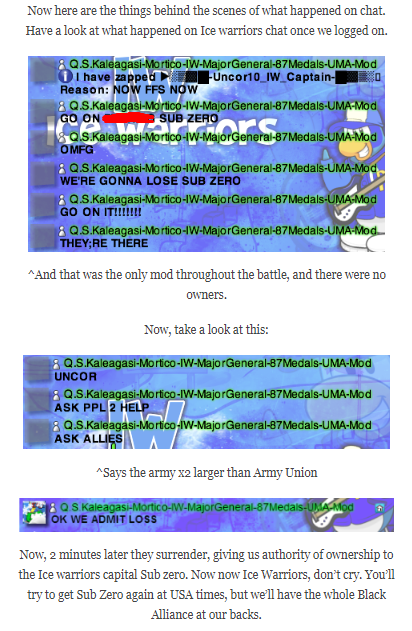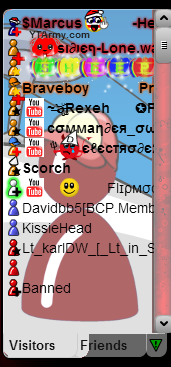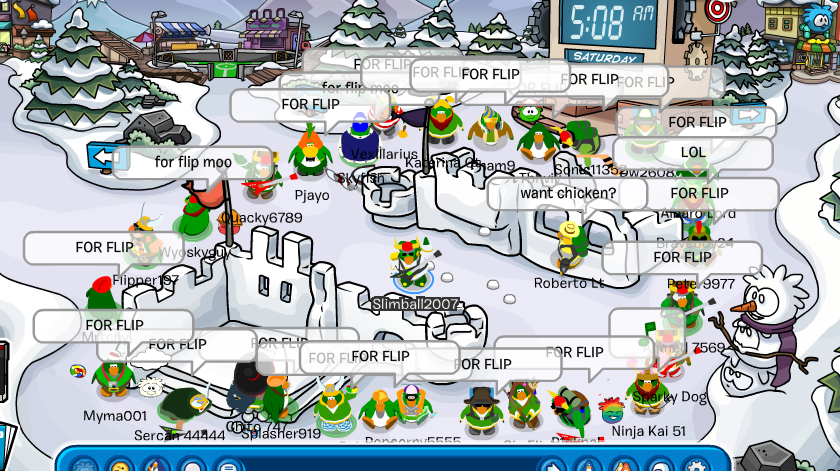Welcome back to Picture Perfect, the column in which photos from years ago are deconstructed with the benefit of hindsight. I present to you an analysis of the earliest AUSIA divisions, as well as AUSIA’s eventual popularisation.

Contrary to what some might assume, the army community was not always blessed with the bounty of AUSIA divisions. Referring to the regions of Australia and Asia, the word “AUSIA” was coined by popular graphics designer Monsoon in 2013. During the leadership of army legend Flipmoo in the Army of Club Penguin, the term was adopted before quickly becoming commonplace in our vocabulary. Flipmoo’s tenure became famous for the feats of his AUSIA division, boasting sizes up to 56 penguins at its peak.

Flipmoo’s largest AUSIA event
This is the narrative that persists throughout the Club Penguin army community, enshrined on this website’s Legends page. Such a reading of history would not be untrue, as the enormous success of Flipmoo did inspire many to establish their own AUSIA divisions. However, having been present from the beginning of what we call AUSIA, I submit to you an unadulterated perspective. This Picture Perfect is not about ACP’s AUSIA success, it is a deconstruction of the popular narrative in honour of the pioneers erased from memory.
Early Days
Prior to the first AUSIA divisions, armies restricted themselves to American and European time-zones. Though individuals from Australia and Asia were present in the community, few would become notable due to unaccommodating time differences. For instance, Australian Western Standard Time (AWST) is normally 12 hours ahead of American Eastern Standard Time (EST). As a schoolchild living in the AWST region, EU and US events were impossible to attend as I’d need to be present at approximately 3:00 AM or 8:00 AM respectively. Some individuals managed to bypass this restriction due to the unique nature of their time-zone, such as Rexeh/Agentrds. His advantage as a New Zealander helped him gain prominence in the Pretzels, becoming leader and legend of the army.
After being recruited to the Ice Warriors in 2011, I learnt there was no place for me in the community. Though I am grateful to Iceyfeet1234 for bringing me into this hellscape, I predictably could not attend many events. Chatrooms were silent during AUSIA hours, but I made as many relationships with my compatriots as I could. Alongside these individuals and several friends from my primary school, we decided to create our own army to fill the AUSIA void. Despite various name changes from 2011 to 2013, the “Army of Darkness” would feature the first known AUSIA division. Though the original website of the army was defaced, CPAD’s “Aus/Asia” division was the point from which the AUSIA community began.

Army of Darkness training event
AUS/Asia Gold Rush
The results of Army of Darkness and its subsequent generations varied, fielding between 3 to 15 penguins at Aus/Asian events. It was through CPAD that I developed further connections with individuals of similar time-zones, such as the Army Republic’s Superaalden. Superaalden became notable for the foundation of AR’s Aus/Asia division, months prior to Flipmoo’s tenure in the Army of Club Penguin. Armies such as Light Troops also attempted to create their own divisions, though records of these efforts are lost to time.

Founding post of AR’s Aus/Asia division
During World War VI, the Black Alliance enlisted the Army of Darkness (which had been re-named to Army Union) as a means to invade the ACP’s White Alliance during Aus/Asian times. Thus, an invasion of IW’s capital Sub Zero on the 10th of November, 2012 would become the first known scheduled Aus/Asian battle. Despite the success of the invaders, the White Alliance refused to acknowledge the invasion due to its unique timing. Although larger armies aligned to the Black Alliance began to take notice of the utility of invasions during Aus/Asian hours, this history had been conveniently forgotten.

Excerpt of the Sub Zero invasion results post
The dawn of 2013 would bring about the strongest Aus/Asian division yet. Following the revival of the American-based Hot Sauce Army, the group sought to expand its empire with new colonies. One of these subjects would be the Heroes, a rebranded continuation of the aforementioned Army of Darkness. With HSA’s new Aus/Asia division, the army used it continuously in wars with the Light Troops, Doritos and Nachos. Several individuals assumed responsibility for leading the Aus/Asia division until HSA’s closure, including Rix15, Fex and I.

Hot Sauce Army and Heroes invade Doritos
History is written by the Clovers victors
It was undeniable that the Hot Sauce Army’s Aus/Asia empire had been the most successful yet, boasting a considerable size and demonstrating success in combat. However, as the HSA began its new frontier, small/medium army legend Flipmoo began to visit the HSA and Heroes chatrooms. Having recently moved to Japan, he observed the new phenomena of Aus/Asian divisions within the army community. Flipmoo began to attend events for Heroes and the Hot Sauce Army, discussing with me the concept of this new division. He soon founded the Army of Club Penguin’s Aus/Asia division, swiftly renamed to “AUSIA”, in May of 2013.

Flipmoo visiting the Heroes chatroom in February 2013
I believe it is difficult to deny that Flipmoo was one of, if not the most effective AUSIA leaders of all time. Diminishing his accomplishments would be unfair, as he indeed led the largest AUSIA division prior to the closure of Club Penguin. Without his division, the ACP’s First Triumvirate Era of 2013-2014 would be but a distant memory. His efforts earned him the title of army legend, a feat few AUSIA individuals have achieved. However, in creating the standard that so many sought to replicate, the works of all that came before would seemingly be erased.

Flipmoo’s retirement event
As a leader of the Army of Club Penguin, Flipmoo and those around him perpetuated the “God of AUSIA” concept. Using this title as his status on XAT chats, a narrative that ACP was the true pioneer of AUSIA began to develop. This was parroted by Club Penguin Army Central. Despite the consistent usage of AUSIA divisions by major armies throughout 2013, Flipmoo’s legend biography falsely credits him for the beginning of AUSIA’s prominence. Flipmoo addressed this erasure of history in a comment on my retirement post, years following his resignation:
During the time the ACP AUSIA Division was starting to receive recognition, I heard that you had created an AUSIA-based army long before I had. Ever since, I felt an unnecessary grudge-like duress that made me want to triumph over your legacy of being the founder of the first AUSIA-based army. It would have been fine if it remained as an emotion of rivalry, but in an attempt to accomplish this I eventually came up with the miserable and puerile idea of materializing the so-called “God of Ausia” title, and proclaiming it as mine. Looking back, I realize how foolish this was. I would like to apologize, but I ask that you do not take it the wrong way. This apology is directed to you and others in the AUSIA community who were victimized by being robbed of their accomplishments and efforts as a result of the creation of such a delusional and misleading title. I am proud of what I have achieved and accomplished during my time in the ACP, but I obviously no longer feel worthy of being addressed by such a title. There is no superiority or inferiority in the process of creation and growth in the AUSIA community, or that is at least how I see it now.
– Flipmoo/Slimball2007
Reflection
What we refer to as AUSIA has changed immeasurably throughout the years. For example, events for the division were originally hosted between 2:00 AM to 6:00 AM EST to allow assistance from Americans who could stay awake. Following the dominance of Flipmoo’s ACP, the AUSIA time standard became 6:00 AM to 9:00 AM EST, which aided European individuals in attending events. Most events now taking place at approximately midnight for those on the Eastern coast of Australia. I don’t think many of you would consider 11:00 PM UK to be a European event, but this is this is the climate Australians find themselves in. If you were a New Zealander, you can forget about attending 1:00 AM AUSIA events. This is only one aspect in which AUSIA has changed.
Over the past decade and a half, numerous AUSIA leaders have made a considerable impact. Some such as Silverburg and CSY are rightfully held in high regard and serve as role models for Oceanic and Asian leaders. However, despite the hard work of all who became before them, they have become forgotten. The friends I worked with tirelessly and acquaintances with similar goals will never get the recognition they deserve, and by now it is too late.
My hope is that we can now continue to celebrate AUSIA consistently as a community. The “AUSIA Arena” tournaments were supposed to be seasonal events to allow AUSIA leaders and troops to partake in the same activities afforded to the EU and the Americas. Where has AUSIA Arena gone? I hope that we do not undo the progress we have made, and I implore the administration to make regular AUSIA tournaments a reality. Thank you to the AUSIA pioneers, past and present, who have made this community one that even more people can enjoy.